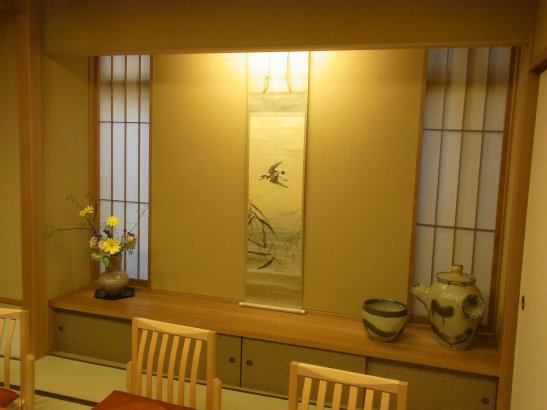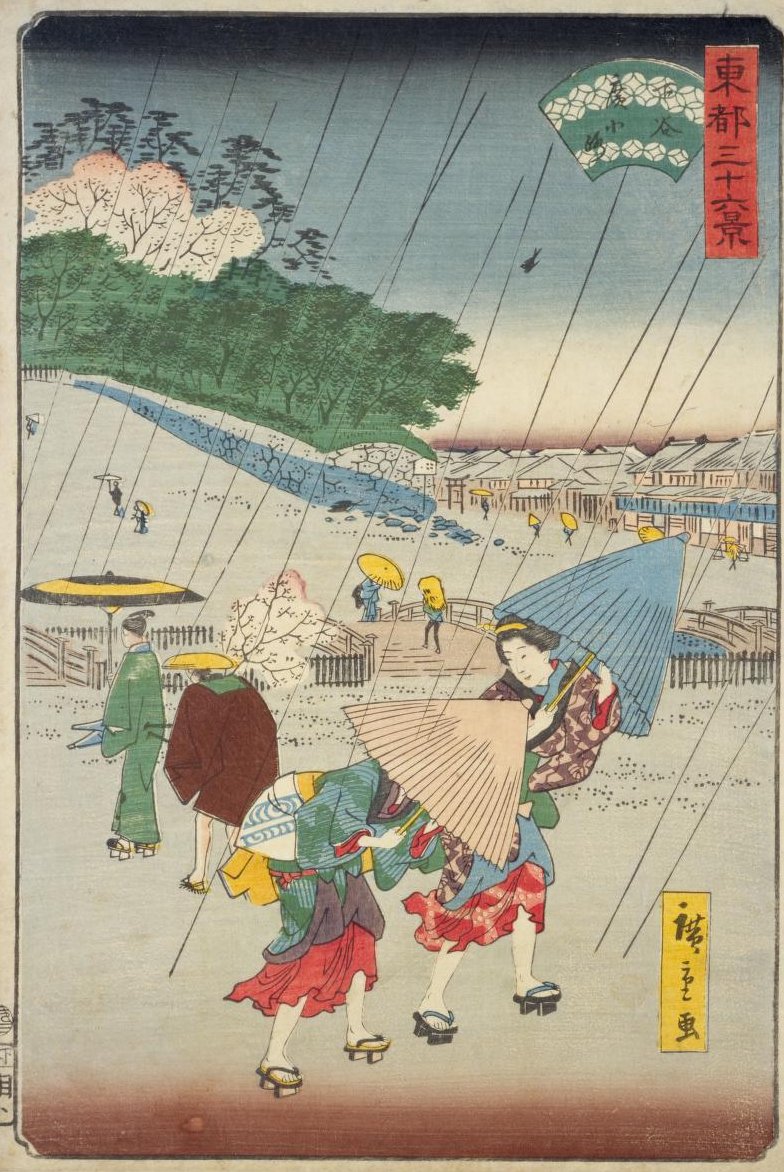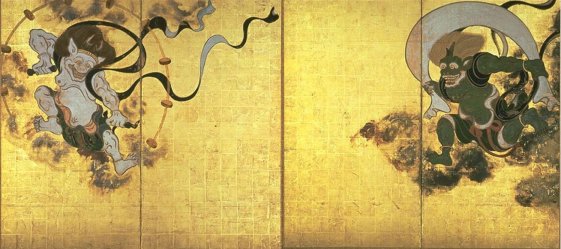
「和紙」は日本の伝統的な紙です。
“Washi 和紙 Paper” is the traditional Japanese paper.
“Washi”
is a unique development in Japan that was introduced from China in the early
7th century.
The word “Washi Paper” comes from “Wa 和” meaning “Nippon 日本Japan/Japanese” and “Shi/Kami 紙Paper”.
All
paper, whether manufactured or “Tezukuri 手作り Handmade”, is
made in basically the same way.
“Washi”
is also used to make various everyday goods like clothes, household goods, and
toys.
Cellulose
fibers of plats or trees are treated and mixed in water.
The
sheet is removed from the screen, then pressed and dried.
In the
case of “Nagashi-suki”, scoop “Shiryō-eki” into the hanging “Sukigeta 漉桁 Frame” from the front.
In “Nagashi-suki”
method, mucilage from “Totoro-aoi 黄蜀葵 Hibiscus manihot”
or “Noriutsugi 糊空木 Hydrangea paniculta” plants is added in order to suspend the fibers in
the “Shiryō-eki”, thicken the mixture, and delay the draining time.
Then,
shake it back and forth to improve the entanglement of the fibers, and then
throw away the excess “Shiryō-eki” to the other side.
Repeat
this several times to adjust the sheet thickness.
This
achieves the interlocking alignment of fibers that provides the strength of “Washi”.
One can
judge the quality of washi by tearing it and examining the fibers.
“Washi”
has much longer fibers than “Yōshi 洋紙 Western paper”, so
it is thin and strong, has a long life, and has a unique texture.
Good “Washi” is made from the fibers of
special bushes, is tear- and insect-resistant, and can last for hundreds of
years.
“Washi” uses the cellulose of four plants, and is classified according to material.
The
invention of “Kami”, like invention of the wheel was gigantic leap in
development that changed the world.
The
ancients invented a method to loosen the hemp fibers and soak them in water,
and then strain them into sheets.
This
paper was suitable for writing letters.
In 751,
the Tang Army and Saracen Army fought in Samarkand, and it is reported that the
POWs of the Tang Army introduced the method of making paper to Saracen.
In 1719,
the French Leo Mule discovered that wasps' nests were made of wood fiber and
came up with the idea of making paper using wood pulp.
伝統的な和室で重要なスペースは、「床の間」として知られる装飾のための壁から引っ込んだところです。
The focal point of any traditional Japanese room is the decorative alcove,
known as the tokonoma.
床のまで最も重要な要素は、掛け軸と呼ばれる吊り下げる巻物です。
The most important feature in this alcove is the hanging scroll, called
kakejiku.
たくさんの種類の掛け軸があります。
There are many kinds of kakejiku.
山水画は、墨で自然の景観を描くのが特徴です。
Sansui-ga feature ink-brush landscape paintings.
花鳥画は、季節の花や鳥を描きます。
Kacho-ga depict seasonal flowers or birds.
仏画は仏教の象徴を描きます。
Butsu-ga convey Buddhist symbolism.
いくつかの掛け軸は、有名な禅僧が書いた書です。
Some kakejiku are inscribed with calligraphy by notable Zen monks.
掛け軸の重要な特徴は、永遠に掛けておくことではありません。
An essential aspect of kakejiku is that they are not intended to be hung
permanently.
掛け軸はこまめに掛けかえられます。
They are changed at frequent intervals.
掛け軸を掛ける楽しみは、お迎えするお客様や季節など、特別な場面にふさわしいものを選ぶことです。
Part of the pleasure of hanging a kakejiku is selecting one that is appropriate for the specific occasion - for the guests who will be receive and the season.
掛け軸は巻くことができるので、簡単に持ち運ぶこともできますし、保管する場所をとりません。
Because hanging scrolls can be rolled up, they are easy to transport and don't need much storage space.
いくつかの掛け軸を用意し、簡単に掛けかえることができます。
So you can keep several kakejiku, and easily change them at any time.
お祝いの宴では、めでたい書を選びます。
For celebrations, a festive inscription is selected.
親しい友達が訪ねてくる時は、カジュアルな絵がふさわしいでしょう。
If a close friend is visiting, the perhaps a casual painting is appropriate.
夏は涼しさ、冬は暖かさを演出します。
Others may evoke coolness in the heat of summer or warmth in winter.
掛け軸の選択は、部屋全体の雰囲気を決定します。
The choice of kakejiku will detemine the feel of the entire room.
掛け軸の真ん中にある絵や書は、本紙と呼ばれます。
The picture or calligraphy in the centre is called the honshi.
本紙を保護し、装飾的にする台紙は表具と呼ばれます。
The mounting, which is both decorative and also serves to protect the honshi, is called the hyogu.
人々は本紙と表具が一体化した芸術として掛け軸を鑑賞します。
People appreciate the combination of the two as one work of art.
それぞれの掛け軸の中に様々な要素が統合され、お客様の目を楽しませます。
Various elements are integrated into each kakejiku to please the eyes
of the guests.
表具とは、布や紙などを張ることによって仕立てられた巻物、掛軸、屏風、襖、衝立、額、画帖などを言います。また、それらを仕立てることを表具または表装と言います。
6世紀半ばに仏教と共に経典が紹介され、表装が重要な仕事になりました。
Sutra were intoroduced with Buddhism in the mid-sixth century, and mounting
them became important work.
室町時代には、寺院の床の間が一般に広がり、安土桃山時代に観賞用の表具がまざましい発展を遂げました。
生活様式や家屋の変化、茶の湯の文化は、掛け軸や屏風、ふすま、本など、それらに表装される絵や書と共に変化を促しました。
Changes in lifestyle and houses and the creation of the tea ceremony encouraged the development of kakejiku, byobu (holding screens), fusuma (sliding doors), books, and so on, with pictures as well as calligraphy on them.

床の間は神聖な場所とされています。
The tokonoma is considered to be a scred place.
水墨画は禅と深い関係があります。
Suiboku-ga have a deep connection with Zen Buddhism.
東洋では、傘は魔除けなどの目的で、高貴な人に差しかける天蓋(開閉できない傘)として古代中国で発明されました。
552年に日本に百済からの使者が渡来したときに日本に伝わりました。当初から唐傘(からかさ)と呼ばれていたようです。
日本では、象徴的な役割やその他も含め、たくさんの使用方法があります。
In Japan, umbrellas have many use - symbolic and otherwise
その起源は雨ではなく、日光を避けるのが目的でした。
Their original use was to shield one from the sun, not the rain.
ラテン語のアンブラも影を意味しています。
"Umbra", after all, means shade in Latin.
平安時代に製紙技術の進歩や竹細工の技術を取り込んで改良されました。
室町時代には和紙に油を塗布することで防水性を持たせ、雨傘としても使用されるようになりました。
ろくろを使って開閉させるための機構の部品をつくり、日本で独自に改良された傘も、唐繰傘(からくりかさ)から略して唐傘と呼ばれました。
江戸時代になると骨の製作と紙の貼付け、そして仕上げに分かれて分業制が発達し、一般に広く普及するようになりました。
Three different artisans used to be involved in making the umbrellas - the spoke carver, the paper paster, and the one who finished things up.
和傘は柿渋、亜麻仁油、桐油等を塗って防水加工した油紙で造られ、漆塗りの軸と木や竹の持ち手があります。
The Japanese-style umbrella (wagasa) is made of oiled rice paper and
has lacquered spokes and a plain wood or bamboo handle.
蛇の目傘は本来、蛇の目に見えるように紙を張り付けた細身で上等な傘です。
番傘は骨が太く、男性向きの頑丈な傘です。和紙の色は白が基本です。
A bangasa is the large, thicke wagasa as opposed to the janome which is
thinner and more feinine.
番傘は作りが粗い雨傘で、商家で客に貸したり、使用人が利用するため、紛失を防ぐ目的で屋号や家紋と共に番号をつけたので、その名がつきました。
歌舞伎の小道具として登場する傘は、雨や強い日差しを避けるためではなく、シンボルとして使用されています。
There are so many symbolic uses of wagasa in Kabuki.
登場人物が差す和傘は、その人の地位を暗示しています。
Wagasa held over a person are used to designate his rank.
番傘が破れている場合、その登場人物が高い地位から転落したことを伝えています。
A bangasa is ripped tells us that this is a man who is about to fall from his elevated noble station.
歌舞伎宗家市川團十郎家のお家芸である歌舞伎十八番の一つとして有名な演目である『助六』では、主人公の助六が花道に登場し、黒縮緬の着付けに江戸紫の鉢巻き姿で、蛇の目傘をさして颯爽と登城し、その傘を使いながら舞踊的な演技を行います。
 東都三十六景 下谷広小路 国立国会図書館 所蔵
東都三十六景 下谷広小路 国立国会図書館 所蔵
木の薄板を重ねたり、また紙を折りたたんで製作する扇は日本で発明され、中国やヨーロッパに伝わりました。
A folding fan is a portable cooling device.
It's easy to carry around folded up, and it can be snapped open in an instant to generate a breeze.
During Japan's muggy summers, a fan is an essential accessory.
Typically, fans are made of bamboo ribs and paper.
The metal pibot, called a kname, is vital for keeping the ribs in place.
If the kaname is fixed too tightly, the fan will not open and close smoothly.
But if it's too loose, the ribs will wobble.
This part must be adjusted delicately, as it will have a great effect on how easy the fan will be to use.
Paper is pasted over this framework, so that the fan will create a slight breeze when it's waved.
But folding fans are more than just cooling devices.
They have long been a part of Japanese culture in innumerable ways.
平安時代にはあおぐという役割だけでなく、儀礼や贈答、コミュニケーションの道具としても用いられました。
歌を書いて贈ったり、花を載せて贈ったりする話が、『源氏物語』をはじめとする多くの文学作品に登場します。
Fans are mentioned frequently in The Tale of Genji, a classic work of Japanese literature.
They're exchaged following lovers' trysts, gifts of flowers are presented on them, and they're used to cover the face in moments of embarrassment; folding fans are often used as a form of silent communication between lovers.
Folding fans also play an important role in the world of the tea ceremony.
When guests bow to greet the host, they place their folded fans horizontally between themselves and the host.
This is an expression of respect.
Folding fans also had an immense impact on the development of Japanese art.
Folding fans have had a major formative influence on Japanese culture.
扇面に絵を描くことから湾曲した形状(扇形)に絵を描く日本画の形式が発達しました。
江戸時代初期の絵師で、日本の美術史上に残る傑作である『風神雷神図屏風』で有名な俵屋宗達は、元々、扇絵師でした。
In the early 17th century, Tawaraya Sotatsu had started out as a fan painter.He
created a folding screen depicting the God of Wind and the God of Thunder.It
is one of the masterpieces in the history of Japanese art.
 『風神雷神図屏風』 俵屋宗達 出典:ウィキペディア
『風神雷神図屏風』 俵屋宗達 出典:ウィキペディア
落語の噺家は扇子と手ぬぐいのような簡単な小道具しか使いません。
Rakugo performers employ only such simple props as a folding fan and a
tenugui cloth.